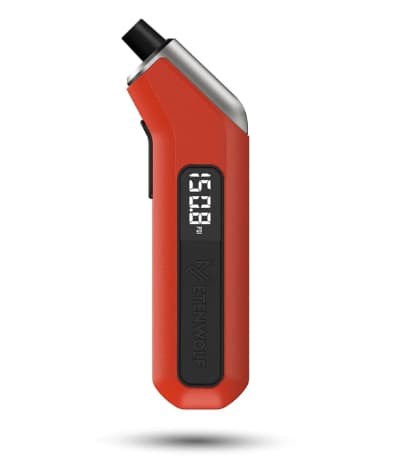Steps to Reset VOLKSWAGEN BEETLE Tire Pressure Monitoring System
Inflate all 4 tires to the recommended air pressures.
Start the engine of the VW Beetle.
Open the glove box.
Press and hold the tire pressure button until you hear a beep noise.
Release the tire pressure button.
WHAT IS TPMS IN THE VW BEETLE?
In the Volkswagen Beetle, the tire pressure is monitored through an indirect version of the Tire Pressure Monitoring System (TPMS). This system infers the pressure levels by interpreting the data from the wheel speed sensors, unlike the direct systems that use dedicated pressure sensors in every tire.
HOW DOES VOLKSWAGEN BEETLE INDIRECT TPMS WORK?
WHEEL SPEED SENSORS
The VW Beetle wheel rotational speed is monitored by wheel speed sensors. These sensors, located in or behind the wheel hub, provide essential information to the vehicle’s central computing system. This information is key for the effective operation of systems like ABS and the indirect TPMS, ensuring they function correctly by tracking the speed of each wheel.
HOW DO WHEEL SPEED SENSORS WORK?
The wheel speed sensors in the Volkswagen Beetle utilize magnetic fields in conjunction with a toothed sensor ring to accurately gauge and transmit the rotational speed of each wheel to the car’s electronic control unit (ECU). These sensors emit electrical signals that fluctuate in frequency proportionate to the speed of the wheel. The Volkswagen’s ECU interprets these fluctuations to determine the rotational velocity of each wheel. This data is vital for several functions, including maintaining vehicle stability with traction control, optimizing braking performance with anti-lock brakes, and accurately monitoring tire pressure.
COMPARING THE WHEEL ROTATIONS
The functioning of the indirect TPMS is based on the concept that a deflated tire will have a reduced diameter, resulting in a quicker rotation rate than its counterparts. By employing wheel speed sensors, the system analyzes and compares the rotation speeds of all the tires. This is the reason the tire pressure monitoring system in the VW Beetle is able to determine the air pressure in each tire with precision only while the vehicle is moving.
DETERMINING THE AIR PRESSURE DIFFERENCES
Through scrutinizing and contrasting the readings from the wheel speed sensors, the Volkswagen Beetle’s tire pressure monitoring system is capable of identifying when a single wheel is rotating faster than the others on a consistent basis. This is an indication of a potential drop in air pressure in the affected tire.
ALERTING THE DRIVER
Should the system detect a considerable variation in wheel rotation speeds, hinting at a decrease in tire pressure, it triggers an alert on the dashboard. The Volkswagen Beetle responds to these scenarios by showing a “low tire pressure” notification, an audible “ding” sound, and with the standard tire pressure warning icon, which is a yellow exclamation point on the dashboard.
THE CAUSES BEHIND CHANGES IN TIRE TREAD CIRCUMFERENCE
Changes in Tire Pressure:
Over-Inflation: Excessively inflating a tire can lead to an increase in its size, thereby enlarging its circumference.
Under-Inflation: A tire with low air pressure has a reduced size.
Wear and Tear Factors:
Tread Reduction: Continuous use leads to tire tread erosion, diminishing the tire’s diameter and consequently its circumference.
Irregular Wear: Misalignment can cause uneven wear, resulting in a non-uniform change in the tire’s circumference.
Effects of Temperature:
Warmth: Elevated temperatures can expand the air inside the tire, marginally enlarging its circumference.
Cold: Cooler air temperature tends to contract, leading to a smaller tire circumference.
Load Impact:
Heavy Load: Additional weight compresses the tire, slightly decreasing its circumference.
Tire Damage:
Sidewall Damage: Bulges and bubbles can alter the tire’s shape and circumference.
Repair Effects: Fixes like tire patches can change the tire’s shape, impacting its circumference.
Tire Type and Quality:
Material Differences: Tires made of different materials might react differently to identical conditions.
Production Discrepancies: Small manufacturing differences can lead to circumference variations even in the same tire model.
Aging Effects:
Rubber Aging: Over time, deterioration of rubber compounds can affect the tire’s flexibility and circumference.
Internal Wear: Breakdown of internal components, like steel belts, can change the tire’s size and shape.
Installation Considerations:
Mounting Issues: Incorrectly mounted tires can lead to an irregular shape and circumference.
Incorrect Rim Size: Fitting a tire on an incompatible rim size can greatly affect its circumference.
WHEN SHOULD YOU RESET THE VOLKSWAGEN BEETLE TIRE PRESSURE SYSTEM?
After adjusting the air pressure in a tire.
Following any service or repair work on a tire or wheel.
Subsequent to the rotation of the tires.
Whenever a tire or wheel is removed and reattached to the Volkswagen Beetle.
When the spare tire has been mounted.
WHAT HAPPENS WHEN YOU RESET THE VW BEETLE TPMS?
When you recalibrate the TPMS in the Volkswagen Beetle by pressing the reset button, you’re effectively creating a new standard for the tire pressure system. Therefore, it’s essential to set the tires to the advised pressure levels while they are cold, before pressing the TPMS reset button.
THE CONSEQUENCES OF LOW TIRE PRESSURE
When tire pressure is too low, it can cause the tires to become overheated, thereby increasing the risk of the tread coming apart and sudden tire blowouts. Underinflated tires experience an increase in sidewall bending and flexing, which heightens the likelihood of them overheating and experiencing sudden malfunctions.
WHY IS THE LOW TIRE LIGHT ON WHEN THE TIRES ARE GOOD?
The tire indicator light in the VW Beetle may illuminate even if the tires look fine and have the correct air pressure, often due to using tires of varying brands or sizes. The car’s indirect TPMS is sensitive to slight discrepancies in tire dimensions or brand, which can cause the low tire pressure warning to activate. Ensuring that all four tires are consistent in terms of size, brand, make, and model is vital.
HOW DO I KNOW WHICH TIRE IS LOW ON THE VW BEETLE?
In the VW Beetle, the in-car display screen specifies which tire is low on air. The TPMS system in the VW bug requires the car to be driving to provide accurate readings. To ensure the tire pressures match the values shown on the screen, I recommend using a digital air pressure gauge. Should the actual tire pressures differ from the displayed values, the reset process should be followed.
IS IT SAFE TO DRIVE THE VOLKSWAGEN BEETLE WITH THE LOW AIR PRESSURE LIGHT ON?
Driving your VW Beetle is not recommended when the low tire pressure indicator is lit. Should the low tire pressure light come on, it’s crucial to find a safe place to pull over and use a digital tire pressure gauge to check the air pressure in each tire. Furthermore, a thorough visual examination of the tires and wheels for any unusual issues, like a nail in the tire, is essential.
HOW MANY MILES CAN YOU DRIVE WITH THE LOW TIRE LIGHT ON?
It is not possible to specify a “safe” time or distance for driving when the low tire pressure indicator is illuminated. It’s prudent to investigate and understand why the low tire pressure warning has been triggered before proceeding with your journey.
VOLKSWAGEN BEETLE TIRE SIZE AND AIR PRESSURE
TIRE SIZE | Front Psi/kPa | Rear Psi/kPa |
215/55R17 | 32/220 | 32/220 |
215/60R16 | 32/220 | 32/220 |
235/45R18 | 32/220 | 32/220 |
WHY DOES THE TIRE AIR PRESSURE INCREASE AS YOU DRIVE?
The pressure in tires increases as a result of heat. In the case of the Volkswagen Beetle, driving for approximately 30 minutes at speeds exceeding 45 mph can lead to a rise in tire pressure between 2-4 psi in each tire. This change is attributed to the heat generated through friction and the flexing of the tires. Consequently, measuring tire air pressure right after a drive does not provide accurate readings.
WILL THE VW BEETLE TIRE PRESSURE LIGHT COME ON IF THE TIRES ARE OVERINFLATED?
In the event of overinflation of your tires, the Volkswagen Beetle’s display screen will provide a notification but the low tire light symbol will not activate. This often happens when the tires get excessively hot. It is advisable in these circumstances to pause your trip and check the air pressure of each tire individually.
THE SOAP AND WATER TRICK FOR LOCATING LEAKS IN TIRES
To detect a leak in a tire that is losing air, implement these steps:
Inflate the tire in question on your Volkswagen Beetle to a minimum pressure of 40 Psi.
Create a mixture of dish soap and water in a spray bottle. (or you can use windex)
Thoroughly spray this mixture all over the tire, paying special attention to the bead area and valve stem.
Look for where bubbles appear and follow them to their point of origin to pinpoint the leak’s source.
Once you find the leak it’s a good idea to mark the puncture location.
Fdg
STEPS TO TAKE WHEN YOUR TIRE LIGHT STAYS ON DESPITE CORRECT AIR PRESSURE
In case the low tire pressure indicator persists even after resetting the TPMS and ensuring all tires are at the advised pressure levels, you can try the following steps:
Inflate each tire 8-10 Psi above the recommended level.
Drive your VW Beetle for a duration of 5-10 minutes.
Deflate the tires to remove the extra air, bringing each back to the recommended pressure.
Take another 5-10 minute drive.
Proceed with the TPMS recalibration procedure by pressing and holding the TPMS button.
WHAT HAPPENS IF A WHEEL SPEED SENSOR STOPS WORKING?
Should a wheel speed sensor be broken or faulty, it adversely affects the performance of the tire pressure monitoring system. This malfunction will cause the low tire pressure warning to flash and cause the TPMS to display inaccurate air pressure readings on the information screen.
CAN A CHANGE IN ALTITUDE TRIGGER THE LOW TIRE PRESSURE LIGHT?
Normally, the tire pressure indicator in your VW Beetle won’t activate just from driving to a higher altitude. As you climb in elevation, the internal pressure of the tires tends to rise. It’s estimated that for every increase of 1,000 feet in altitude, there’s a corresponding increase of about 0.5 Psi in tire pressure.
CAN THE VW BEETLE TPMS BE DISABLED?
The Volkswagen Beetle tire pressure monitoring system cannot be disabled.
USING WINTER TIRES OR A CHANGE OF WHEELS
When switching to winter tires or a different set of wheels and tires on your Volkswagen Beetle, it’s crucial to register this change as a new set by pressing the TPMS reset button. Not doing so might trigger the low tire pressure alert in your vehicle.
WILL THE WEATHER TRIGGER THE TIRE LIGHT?
It’s common to see the low tire pressure indicator light up in cooler temperatures. This is due to the fact that a 10°F change in ambient temperature can result in a tire pressure variation of about 1 Psi (6.8 kPa). So, in a scenario where the temperature falls by 41°F across 5 weeks, the tire pressure in your Volkswagen Beetle might reduce from 32 Psi to 28 Psi, thereby triggering the tire pressure warning.
HOW UNDERINFLATED TIRES AFFECT FUEL EFFICIENCY IN THE VW BEETLE
It’s crucial to keep your Volkswagen Beetle’s tires properly inflated to ensure optimal fuel economy. Tires that are not sufficiently inflated increase rolling resistance, thereby making the engine work harder and use more fuel. Losing 1-2 Psi in all 4 tires can lead to a fuel efficiency decrease of about 0.2-0.4%. For a clearer understanding, in a vehicle like the Volkswagen Beetle, which averages 26-33 Mpg, a 1% reduction in fuel efficiency means using more fuel – about 2 gallons for every 3,000 miles driven.
ARE TIRE PLUGS SAFE TO USE?
With a background of ten years as a professional car mechanic, I often turn to tire plugs for repairing punctures. Tire plugs, when correctly used, can offer a reliable fix that lasts as long as the tire itself. However, it’s vital to refrain from using tire plugs on tires that have significantly worn out treads or on the sidewall. In cases of larger punctures or leaks, it’s preferable to go for a tire patch or to replace the tire entirely.
Everything in this article is applicable to all Volkswagen Beetle models and versions built between 2011-2019.
Please note that this blog post contains Amazon affiliate links. This means that if you make a purchase through one of these links, we at TPMSRESET.COM may earn a small commission at no extra cost to you. We only recommend products that we personally use and believe in. Thank you for supporting us.






